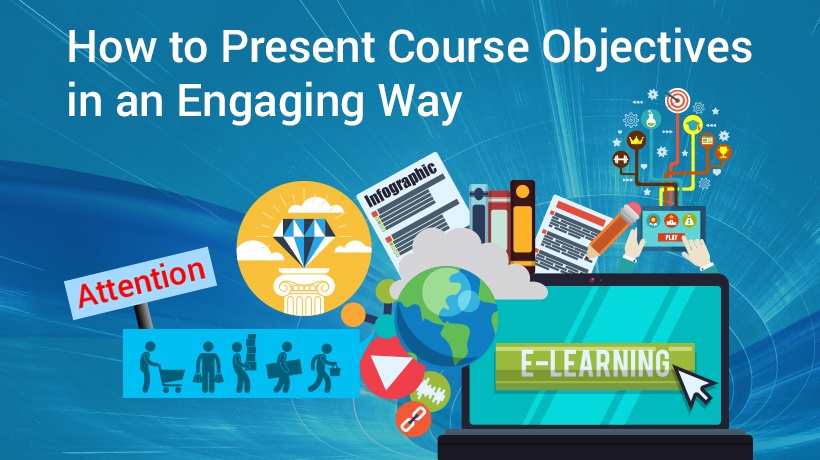How To Present Course Objectives In An Engaging Way
Every Instructional Designer wants to achieve maximum participation for the course that he/she has developed. It takes a lot of effort for the Instructional Designer to ideate and create courses in such a way that they are engaging and easy to understand. The first thought that hits the shores of any Instructional Designer’s mind is defining the right course objectives. Since course objectives define the purpose of the course and help learners slide through it efficiently, it is important that they are presented well. Understanding the objectives also helps learners know what they would achieve from the course. These objectives are also used as a basis to decide what to include in the course, how to design learning activities and course evaluations.
Presenting Engaging Course Objectives: 7 Ways
In this article, I would cover multiple interesting ways of presenting course objectives that Instructional Designers or course developers need to consider when ideating online courses. The simplest example is the bulleted list that is present at the start of many courses, it is crisp, to the point, and well summarized. However, in some scenarios, a bulleted list may not be effective in imparting knowledge. It may lack to bridge between two different sections or points that are covered in the course. To mitigate this gap and to bring out effective learning, make sure your learners interact with the content in a different way than what is usual for them. Learners may face boredom from the same type of slides developed in a presentation, and as mentioned, bullet points are history.
So let us now explore some unique and interesting ways of presenting course objectives that can engage learners right at the onset:
1. Lie To The Learners.
Lying in an ethical way boosts learner morale to achieve more. Lying to your learners about a point in your course right can sometimes even challenge them to prove you wrong. You might set up realistic expectations and then gradually guide them through your lie. Of course, learners may achieve that, but if they do not, they would land up somewhere close.
2. Infographics.
Photographic memory has a lasting impression; consider implementing detailed infographics incorporating learning objectives. You can make use of icons, text, and images in the infographic to bring out an engaging experience. You can group multiple objectives and relate them in the infographic, add a sequence to simplify the experience.
3. Videos.
Short clips or videos are great when it comes to imparting course objectives. Read the objectives with short description loud and clear so the user is clear with them. You can record a short video of a Subject Matter Expert/employee or the CEO about the learning objectives in a learner friendly language and context. Learners can quickly relate to these objectives which simplify their learning experience.
4. Success Stories.
Create a short success story and embed the objectives in parts of the story. You can decide the theme of the story which would suit the objectives, inspirational/success are some of the common ones used. In most scenarios the story approach works fantastic, learners are connected to the content right from the start.
5. Attention Grabbers.
Highlight the important chunks in the learning course through high intensity colors and text sizes. You may want to bring up statistics, news, or even surprising facts that are related to the course. To add up, you can consider adding external facts relating to the course topic.
6. Scenarios.
Make use of a scenario build out of the course objectives. Then present these objectives as solutions to the course. Learners would invest time in finding the solutions as well as gaining knowledge on the course objectives together at the same time. The scenario can be aligned with the course topic, learners would find it easy to relate. Raptivity offers a wide range of scenario based templates. Refer to the below screenshots for a quick idea:
 Fig – How to handle an irate customer call scenario
Fig – How to handle an irate customer call scenario
7. Gamification.
Include games that enable user interaction at maximum. Interactive games where winning unlocks the objectives are fun and interesting to play. Learners are focused in finishing a game where the objective of the course is clear. You can even add up a creative image where the status or the achieved objective is highlighted in different colors. There are many tools in the market that provide game based interaction templates, Raptivity being a prominent tool for that purpose. You could pick out the ones that suit your purpose.
Final Thoughts
The above-mentioned points are some of the preferred and widely used ways through which course objectives can be showcased in an online course. If you know of, or have used other interesting ways to present course objectives, do share them with us.
Raptivity offers a pool of 190+ highly customizable interactions, which can be implemented in the form of text, questions, fonts, images, audio, video, and much more. Moreover, it has helped Instructional Designers and content developers to add course objectives as a part of interactivity in a cost-effective way.
Interested to know more about Raptivity, click here to contact us or simply write to us at [email protected].








